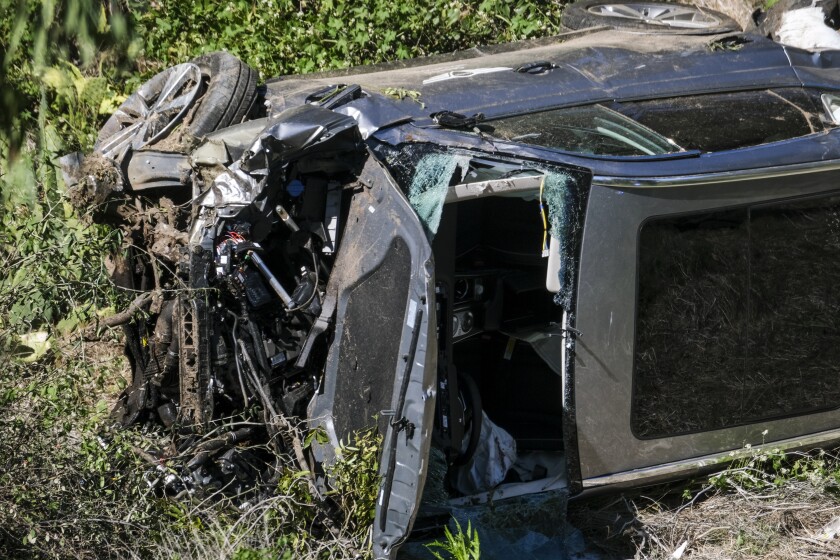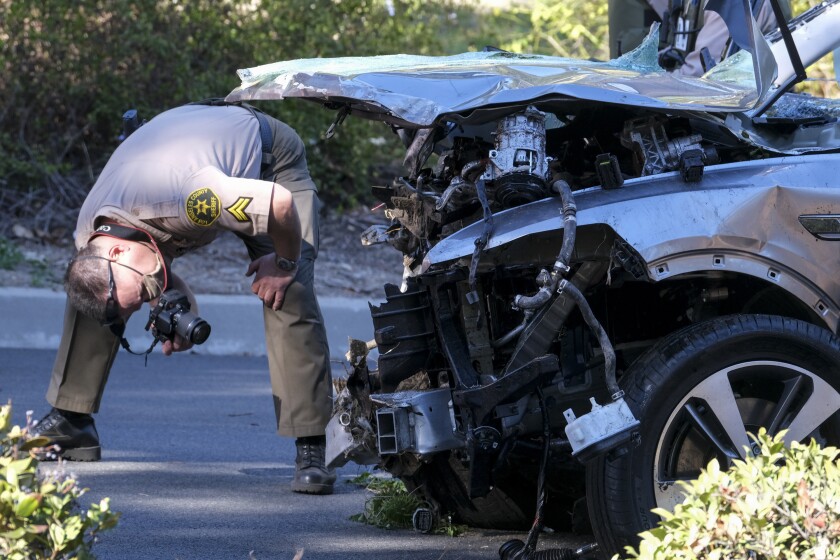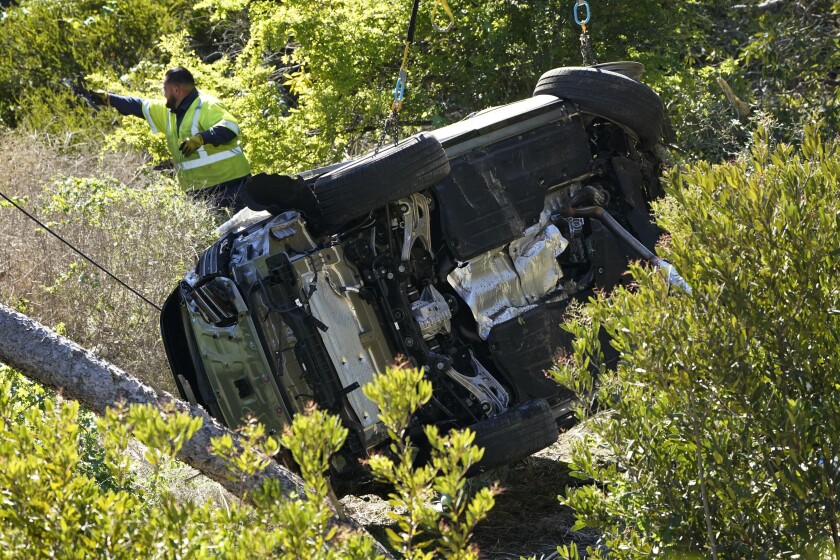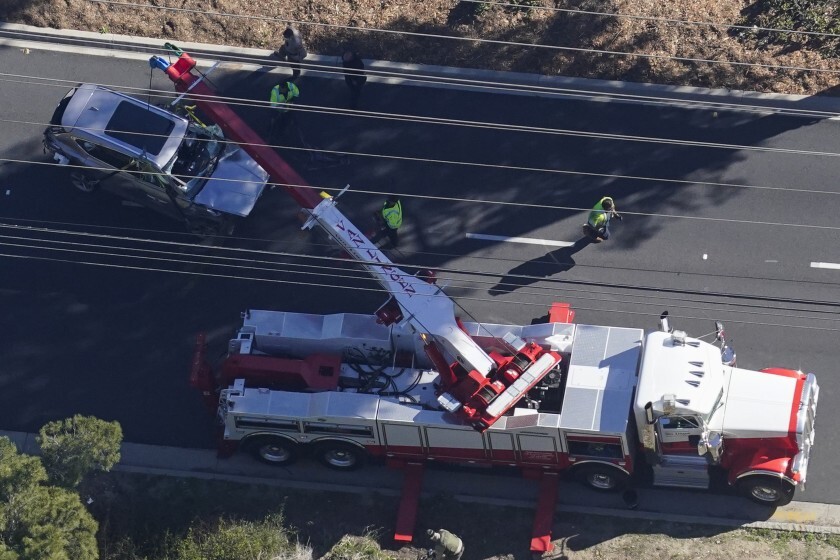Tiger Woods has told authorities he doesn’t remember the rollover crash that landed him in a hospital with metal rods and pins in his leg.
But the SUV he was driving does.
Like other modern cars and trucks, the Genesis GV80 that Woods was driving when he crashed was equipped with an electronic data recorder and other computer hardware meant to serve as a digital witness of sorts — filled with information investigators can use to piece together the seconds before and during the accident.
The devices are part of a broader array of safety technology built into many newer vehicles. Vehicles in the Genesis line — Hyundai’s luxury brand — for example, also feature artificial intelligence software that keeps a watchful eye, sending alerts if it detects the driver is distracted or closes his or her eyes while driving.
It was not surprising, then, that as part of their effort to understand what led Woods to lose control on a curvy Palos Verdes Peninsula highway on Feb. 23, investigators from the Los Angeles County Sheriff’s Department executed a search warrant this week to retrieve the data contained on the SUV’s computers. Information on how fast Woods was going, whether he ever hit the brakes, and other clues could be critical to reconstructing the the crash that left the 45-year-old Woods’ golfing future in limbo.
“They did a search warrant to secure in essence the black box of the vehicle, that is all it is,” Los Angeles County Sheriff Alex Villanueva said on Wednesday. “They are going to go through it and see what was the performance of the vehicle, what was happening at the time of the impact, and with that more information they attribute the cause of the crash.”
Woods told investigators he has no recollection of what happened. In the hours after the crash, as Woods underwent surgery at Harbor-UCLA Medical Center to have pins and rods inserted into his shattered lower right leg, sheriff’s investigators did not seek a warrant needed to run toxicology reports to see if Woods was drunk or under the influence of drugs.
Deputy Carlos Gonzalez, the crash lead investigator in the case and the first deputy to arrive at the scene, has said publicly that he did not observe anything that led him to suspect Woods was under the influence of anything and so he had no legal grounds for testing the golfer for alcohol, narcotics or prescription drugs. Woods was calm and lucid, he added. Villanueva also said no evidence suggested the golfer’s actions rose to reckless driving.
“You can have driver’s inattention, you can have any distraction like that, you can have speed involved,” the sheriff said last week. “The point of contact where he hit the center median is downhill and a curve, and that stretch of road has had quite a few accidents over the years.”
Keith Swensson, a retired sheriff’s commander who knows the stretch well as a local resident, said drivers sometimes fail to follow the curve of the downhill stretch and, like Woods, veer across oncoming traffic and it sometimes proves deadly.
Experts say data retrieved from the Genesis may reveal why Woods did not successfully navigate the curve. Under National Highway Traffic Safety Administration requirements for more recently built vehicles, information recorded includes the engine RPM, steering, length and force of the crash, G forces on the car and what braking occurred during a crash.
According to a source not authorized to discuss the probe, investigators seeking the warrant cited a lack of skid marks or other signs of braking as the reason the data are needed to determine why the vehicle careened through a Rolling Hills Estates sign and across opposing traffic before hitting a curb, snapping a tree and rolling over on a hillside. During the last 14 months, there have been 13 other crashes on the stretch of road. Investigators determined a cause in 11 of those wrecks.
The Driver Privacy Act of 2015 requires the protection of a driver’s data privacy, so a law enforcement agency must obtain a search warrant to access such information.
Experts say an SUV like the Genesis may have also captured data to show whether Woods received a warning alert for inattentive driving in the moments before impact.
“There is a lot more data in a car beyond the [event data recorder],” said Andrea Amico, CEO and founder of Privacy4Cars. Amico said his company examined other vehicles with systems to warn a driver if they are distracted similar to the Genesis’ “Forward Attention Warning” and found it recorded when it sent warnings. Amico said it is not proof a driver was distracted, but an opinion of the vehicle.
Amico said he suspects the sheriff’s search warrant will cover other data in the vehicle beyond the data recorder.
In this case, how far investigators go may be limited by the lack of death or serious injury of another person. In cases where the National Transportation Safety Board investigates and there are multiple fatalities, it has the ability to extract far more data and gather as much as possible.
Black box data have been used in vehicular homicide cases for about a decade. In 2012, former “Melrose Place” actress Amy Locane was convicted of second-degree vehicular homicide and fourth-degree assault by vehicle in a 2010 drunk driving fatality, a case in which the judge allowed the use of black box data from her SUV.
Privacy advocates like Amico say the vehicle’s infotainment system may also provide a plethora of information. He said when a driver gets behind the wheel, they typically synchronize their cell phone to the vehicle’s infotainment system and “that creates a mini clone of their phone in the car.”
“All of their texts, phone calls, contacts, camera data, and thousands of pieces of personal data are stored,” Amico said.







